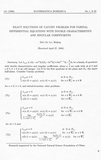Article
Full entry |
 PDF
(1.2 MB)
Feedback
PDF
(1.2 MB)
Feedback
 PDF
(1.2 MB)
Feedback
PDF
(1.2 MB)
Feedback
Keywords:
exact solutions; Cauchy problem; singular coefficients; double characteristics
exact solutions; Cauchy problem; singular coefficients; double characteristics
Summary:
Let $ L_{a, b}\eq(\pa_x-ax^k\pa_t)(\pa_x-bx^k\pa_t)+kbx^{k-1}\pa_t -kx\pa_x $ be a family of operators with double characteristics and singular coefficients, where $a$, $b$ are reals with $ab\ne0$ and $a\ne b$, $k>0$ is an odd integer. Let $\ome$ be the first quadrant in the plane and $H_+$ the upper half-plane. Consider Cauchy problems
\cases{L_{a,b}u=0 & in $\ome or H_+$, \cr u(x, 0)=\vp_0(x), u_t(x, 0)=\vp_1(x) \quad& for $x \in\ov{{{\Bbb R}}_+} or x \in{{\Bbb R}}$ \cr} \eqno(P_1)
for $a>0$, $b>0$, and initial-boundary value problems
\cases{L_{a, b}u=0 & in $\ome or H_+$, \cr u(x, 0)=\vp_0(x), u_t(x, 0)=\vp_1(x) \quad& for $x \in{\ov{{{\Bbb R}}_+}} or x\in{{\Bbb R}}$, \cr u(0, t)=\psi_0(t) & for $t\in\ov{{{\Bbb R}}_+}$,\cr} \eqno(P_2)
\cases{L_{a, b}u=0 & in $\ome or H_+$, \cr u(x, 0)=\vp_0(x), u_t(x, 0)=\vp_1(x) \quad& for $x \in{\ov{{{\Bbb R}}_+}} or x \in{{\Bbb R}}$, \cr\displaystyle\lim_{{(x, \tau) \to(0, t), x \ne0} \atop{(x, \tau)\in\ome or H_+}} \d{u_x(x, \tau)}{x^k}=\psi_1(t) & for $t \in\ov{{{\Bbb R}}_+}$ \cr} \eqno(P_3)
for $ab<0$ and
\cases{L_{a, b}u=0 & in $\ome or H_+$, \cr u(x, 0)=\vp_0(x), u_t(x, 0)=\vp_1(x) \quad& for $x \in{\ov{{{\Bbb R}}_+}} or x\in{{\Bbb R}}$, \cr u(0, t)=\psi_0(t), \displaystyle\lim_{{(x, \tau)\to(0, t), x \ne0} \atop{(x, \tau)\in\ome or H_+}}\d{u_x(x, \tau)}{x^k} \! \! \! & = $\psi_1(t) \quad for t \in\ov{{{\Bbb R}}_+}$ \cr} \eqno(P_4)
for $a<0$, $ b<0$. Under appropriate smoothness conditions on $\vp_0$, $ \vp_1$, $ \psi_0$ and $\psi_1$, we obtain different sufficient and necessary conditions for each problem to have classical solutions. Moreover, we obtain also explicit expressions of solutions in each case.
References:
[1] Z .J. Lu: Existence of solutions of the non-homogeneous Goursat problem for a class of partial differential equations with double characteгistics. J. Math. Res. & Expositions (1986), no. 2, 40-49. English edition.
[2] Z. J. Lu M. C. Mai, G. Y. Wang: Discrete phenomena in existence in the initial value problems. Scientia Sinica 22 (1979), no. 11, 1229-1237. MR 0557330 | Zbl 0424.35052
[3] A. Menikoff: Uniqueness of the Cauchy problem for a class of partial differential equations with double characteristics. Indiana Univ. Math. J. 25 (1976), no. 1, 1-23. DOI 10.1512/iumj.1976.25.25001 | MR 0399626 | Zbl 0317.35078
[4] F. Trèves: Discrete phenomena in uniqueness in the Cauchy problem. Proc. Amer. Math. Soc. 46 (1974), no. 2, 229-233. DOI 10.2307/2039900 | MR 0352679

